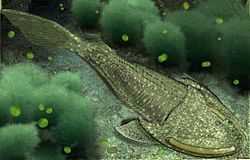Cephalaspis
| Cephalaspis Temporal range: Early Devonian 415–398Ma | |
|---|---|
 | |
| Digital recreation of Cephalaspis | |
| Scientific classification | |
| Kingdom: | Animalia |
| Phylum: | Chordata |
| (unranked): | Cephalaspidomorphi |
| Class: | Osteostraci |
| Genus: | Cephalaspis |
| Species | |
| |

Cephalaspis (head shield) was a genus in the class Osteostraci of Palaeozoic armoured jawless fishes, or ostracoderms. It was a medium sized detritivorous fish that lived in freshwater streams and estuaries of the early Devonian.
Anatomy and morphology
Like its immediate osteostracan ancestors, Cephalaspis was heavily armored, presumedly to defend against predatory placoderms and eurypterids, as well as to serve as a source of calcium for metabolic functions in calcium-poor freshwater environments. It had sensory patches along the rim and center of its head shield, which were used to sense for worms and other burrowing organisms in the mud.
Diet
Because its mouth was situated directly beneath its head, Cephalaspis was thought of as being a bottom-feeder, akin to a heavily armoured catfish or sturgeon. It moved its plow-like head from side to side, Cephalaspis easily stirring sand and dust into the water, along with revealing the hiding places of its prey, digging up worms or crustaceans hidden in the mud and algae, as well as sifting through detritus (inferred from its lack of jaws and inability to bite).[1]
Evolutionary history and phylogeny
The makers of the documentary Walking with Monsters suggested that Cephalaspis, or one of its relatives, was an ancestor to jawed fish and other gnathostomes.
However, Cephalaspis belongs to the Osteostraci, a group which is widely believed to be the sister group to all jawed vertebrates.[2] So whilst Cephalaspis was not a direct ancestor of the jawed vertebrates, Cephalaspis and jawed vertebrates nevertheless shared a common ancestor.
-

Cephalaspis lyellii
-
Cephalaspis lyelli fossil
-

Cephalaspis
In popular culture
As discussed above, Cephalaspis was featured in Walking with Monsters, being pursued by the giant marine scorpion, Brontoscorpio anglicus. Cephalaspis first appeared in early Devonian strata, whereas B. anglicus is known only from the upper Silurian. The program suggested that Cephalaspis, like salmon, migrated upstream to fresh water habitats to spawn, but there is no evidence to prove this behavior.
References
- ↑ Haines, Tim; Chambers, Paul (2005). The complete guide to prehistoric life. Buffalo, N.Y.: Firefly Books. p. 23. ISBN 978-1-55407-181-4.
- ↑ Janvier, P (1996) Early Vertebrates, OUP; Donoghue and Smith (2001) The anatomy of Turinia pagei (Powrie), and the phylogenetic status of the Thelodonti, Transactions of the Royal Society of Edinburgh: Earth Sciences, 92, p.15-37
External links
Bibliography
- Janvier, P (1996) Early Vertebrates Oxford University Press;
- Donoghue and Smith (2001) The anatomy of Turinia pagei (Powrie), and the phylogenetic status of the Thelodonti, Transactions of the Royal Society of Edinburgh: Earth Sciences, 92, p. 15-37
